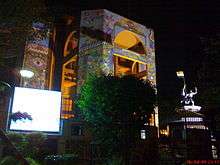Kendriya Vidyalaya
| Kendriya Vidyalaya Sangathan केन्द्रीय विद्यालय संगठन | |
|---|---|
|
Tatvam Pooshan Apaavrunu | |
| Location | |
| India | |
| Information | |
| Established | December 15, 1963 |
| School board | Central Board of Secondary Education (CBSE) |
| Authority | Ministry of Human Resource Development |
| Website |
www |
The Kendriya Vidyalayas are a system of central government schools in India that have been instituted under the aegis of the Ministry of Human Resource Development (MHRD). It comprises over a thousand schools in India and three abroad.
The system came into being in 1963 under the name 'Central Schools'. Later, the name was changed to Kendriya Vidyalaya. All the schools are affiliated to the Central Board of Secondary Education (CBSE). Its objective is to educate children of the Indian Defence Services personnel who are often posted to remote locations. With the army starting its own Army Public Schools, the service was extended (but not restricted) to all central government employees.
A uniform curriculum is followed by these schools all over India. By providing a common syllabus and system of education, the Kendriya Vidyalayas are intended to ensure that the children of government employees do not face education disadvantages while their parents are transferred from one location to another. The schools have been operational for over fifty years.[1]
The Kendriya Vidyalaya Sangathan, which literally translates to 'Central School Organisation', oversees the functioning of these schools and has its headquarters in New Delhi. The administration of this body is based on levels; the chairman of Kendriya Vidyalaya Sangathan is always the Minister of Human Resource Development of the Government of India, and the deputy chairman is Minister of State of MHRD. The real working power lies with the Commissioner of KVS; there are additional commissioners to accompany Commissioner in the administration of KVS in different fields. The head of a KVS region is Deputy Commissioner accompanied by an Assistant Commissioner. There are individual principals of every KV administering the school.
Locations

As of March 2016, there were 1128 schools named Kendriya Vidyalayas. Kendriya Vidyalaya is one of the longest chain of school in world with 1125 schools in india and 3 operated in foreign.[2] A total of 1,209,138 students (as of 30 September 2015) and 56,445 employees were on the rolls (as of 1 September 2013). These were divided among 25 regions, each headed by a deputy commissioner.[3]
The three Kendriya Vidyalayas outside India are in Kathmandu, Moscow and Tehran. They are intended for children of Indian embassy staff and other expatriate employees of the government of India. One school in Tshimalakha, Bhutan, was transferred to the Bhutanese government, thus ceasing to be a Kendriya Vidyalaya (then known as Indo-Bhutan Central School (IBCS)) in 1989, after one of the major Indo-Bhutan projects (the Chukhha Hydal power project) was near completion and Indian government employees were gradually transferred back to their own country.
Features
All the schools share a common syllabus and offer bilingual instruction, in English and Hindi languages. They are co-educational. Sanskrit is taught as a compulsory subject from classes VI to VIII and as an optional subject until class XII. Students in classes VI to VIII could study the German language until November 2014, when the scheme was discontinued. In Moscow, students are given an opportunity to choose French or Russian as their third language.
Tuition fees are charged for boys from class IX onward,[4] and students have to pay the school development fund (Vidyalaya Vikas Nidhi), with the proceeds spent on the development of that particular school. Students from Scheduled Castes and Scheduled Tribes and children of KVS employees are exempt from tuition fees. Girls who are their parents' only child from class VI onwards are exempt from tuition and school development fund payments.[5] All members of parliament can recommend up to six students from their constituency for admission to a Kendriya Vidyalaya. From the academic session 2016-17, the quota has been increased to 10 students.[6]
Kendriya Vidyalaya Sangathan has started seeking quality accreditation for its schools. The Quality Council of India (QCI) has accredited eight schools: KV No. 1 Uppal (Hyderabad), KV AFS Manauri (Allahabad), KV Sector-8 RK Puram (New Delhi), KV Bettiah (West Champaran, Bihar), KV No. 1 (Jammu), KV IIT Powai (Mumbai). KV Ganeshkhind (Pune), and KV No-1 BBSR (Bhubaneswar).[7]
See also
References
- ↑ "Kendriya Vidyalaya". Kendriya Vidyalaya Sangathan. National Informatics Centre (NIC), Government of India. Retrieved 7 September 2010.
- ↑ "KVS homepage". Kendriya Vidyalaya Sangathan. Archived from the original on 25 June 2014.
- ↑ "Kendriya Vidyalaya Sangathan". Kvsangathan.nic.in. 2013-03-31. Retrieved 2016-03-06.
- ↑ "Fee structure per month". Kendriya Vidyalaya Sangathan.
- ↑ "Category wise exemption from payment of Tuition fee, VVN & Computer Fund" (PDF). Kendriya Vidyalaya Sangathan.
- ↑ "Kendriya Vidyalaya Admissions Quota Raised for MPs". The New Indian Express. 2 December 2015.
- ↑ Banerjee Rumu (28 August 2009). "With Rating System, KVs Better Their Best...". Times of India. Retrieved 7 September 2010.
External links
| Wikimedia Commons has media related to Kendriya Vidyalaya. |
